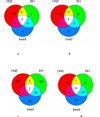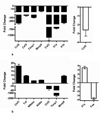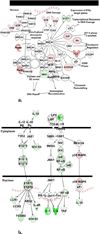Comparative analysis of gene expression changes mediated by individual constituents of hemozoin
- PMID: 19191707
- PMCID: PMC4208677
- DOI: 10.1021/tx8002752
Comparative analysis of gene expression changes mediated by individual constituents of hemozoin
Abstract
Plasmodium protozoa, the source of malarial infections, catabolize large quantities of hemoglobin during an intraerythrocytic phase. During this process, free heme is detoxified through biomineralization into an insoluble heme aggregate, hemozoin (Hz). In its native state, Hz is associated with a variety of lipid peroxidation products including 4-hydroxy-2-nonenal (HNE). In the present study, gene expression profiles were used to compare responses to two of the individual components of Hz in a model macrophage cell line. LPS-stimulated RAW 264.7 cells were exposed to HNE and the synthetic form of Hz, beta-hematin (BH), for 6 or 24 h. Microarray analysis identified alterations in gene expression induced by exposure to HNE and opsonized BH (fold change, > or = 1.8; p value, < or = 0.01). Patterns of gene expression were compared to changes induced by an opsonized control latex bead challenge in LPS-stimulated cells and revealed that the BH response was predominantly phagocytic. Ingenuity Pathway Analysis demonstrated that HNE mediated a short-term oxidative stress response and had a prolonged effect on the expression of genes associated with categories of "Cell Cycle", "Cellular Assembly and Organization", "DNA Replication, Recombination, and Repair", and "Cellular Development". Comparisons of expression changes caused by BH and HNE with those observed during malarial infection suggest that BH and HNE are involved in inflammatory response modulation, altered NF-kappaB signal transduction, extracellular matrix (ECM) degradation, and dyserythropoiesis. HNE exposure led to several significant steady-state expression changes including repressed chemokine (C-C motif) ligand 5 (Ccl5), indicative of dyserythropoiesis, and a severe matrix metalloproteinase 9 (Mmp9)/tissue inhibitor of metalloproteinase 1 (Timp1) imbalance in favor of ECM proteolysis.
Figures




Similar articles
-
Impact of 4-hydroxynonenal on matrix metalloproteinase-9 regulation in lipopolysaccharide-stimulated RAW 264.7 cells.Cell Biochem Funct. 2015 Mar;33(2):59-66. doi: 10.1002/cbf.3087. Epub 2015 Feb 6. Cell Biochem Funct. 2015. PMID: 25663587
-
The basis of the immunomodulatory activity of malaria pigment (hemozoin).J Biol Inorg Chem. 2006 Oct;11(7):917-29. doi: 10.1007/s00775-006-0147-0. Epub 2006 Jul 26. J Biol Inorg Chem. 2006. PMID: 16868743
-
Inhibition of erythropoiesis in malaria anemia: role of hemozoin and hemozoin-generated 4-hydroxynonenal.Blood. 2010 Nov 18;116(20):4328-37. doi: 10.1182/blood-2010-03-272781. Epub 2010 Aug 4. Blood. 2010. PMID: 20686121
-
Proatherogenic effects of 4-hydroxynonenal.Free Radic Biol Med. 2017 Oct;111:127-139. doi: 10.1016/j.freeradbiomed.2016.12.038. Epub 2016 Dec 29. Free Radic Biol Med. 2017. PMID: 28040472 Review.
-
Systems analysis of protein modification and cellular responses induced by electrophile stress.Acc Chem Res. 2010 May 18;43(5):673-83. doi: 10.1021/ar900286y. Acc Chem Res. 2010. PMID: 20218676 Free PMC article. Review.
Cited by
-
Metabolic impact of 4-hydroxynonenal on macrophage-like RAW 264.7 function and activation.Chem Res Toxicol. 2012 Aug 20;25(8):1643-51. doi: 10.1021/tx3001048. Epub 2012 Aug 9. Chem Res Toxicol. 2012. PMID: 22799741 Free PMC article.
-
Bone Marrow Erythroblastic Dysplasia on Morphology Correlates Significantly with Flow Cytometric Apoptosis and Peripheral Blood Eryptosis.J Microsc Ultrastruct. 2023 Feb 7;13(1):1-7. doi: 10.4103/jmau.jmau_97_22. eCollection 2025 Jan-Mar. J Microsc Ultrastruct. 2023. PMID: 40351748 Free PMC article.
-
Host matrix metalloproteinases in cerebral malaria: new kids on the block against blood-brain barrier integrity?Fluids Barriers CNS. 2014 Jan 27;11(1):1. doi: 10.1186/2045-8118-11-1. Fluids Barriers CNS. 2014. PMID: 24467887 Free PMC article.
-
Natural haemozoin induces expression and release of human monocyte tissue inhibitor of metalloproteinase-1.PLoS One. 2013 Aug 14;8(8):e71468. doi: 10.1371/journal.pone.0071468. eCollection 2013. PLoS One. 2013. PMID: 23967215 Free PMC article.
-
Distinct mechanisms of inadequate erythropoiesis induced by tumor necrosis factor alpha or malarial pigment.PLoS One. 2015 Mar 17;10(3):e0119836. doi: 10.1371/journal.pone.0119836. eCollection 2015. PLoS One. 2015. PMID: 25781011 Free PMC article.
References
-
- Greenwood B, Mutabingwa T. Malaria in 2002. Nature. 2002;415:670–672. - PubMed
-
- Urquhart AD. Putative pathophysiological interactions of cytokines and phagocytic cells in severe human falciparum malaria. Clin. Infect. Dis. 1994;19:117–131. - PubMed
-
- Pagola S, Stephens PW, Bohle DS, Kosar AD, Madsen SK. The structure of malaria pigment β-haematin. Nature. 2000;404:307–310. - PubMed
-
- Goldie P, Roth EF, Jr, Oppenheim J, Vanderberg JP. Biochemical characterization of Plasmodium falciparum hemozoin. Am. J. Trop. Med. Hyg. 1990;43:584–596. - PubMed
Publication types
MeSH terms
Substances
Grants and funding
LinkOut - more resources
Full Text Sources
Molecular Biology Databases
Research Materials
Miscellaneous

